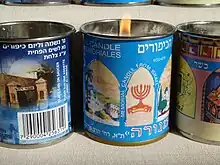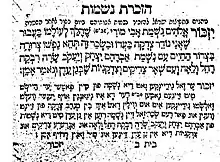
Hazkarat Neshamot (Hebrew: הַזְכָּרַת נְשָׁמוֹת, lit. 'recalling of the souls'),[note 1] commonly known by its opening word Yizkor (Hebrew: יִזְכּוֹר, lit. 'may [God] remember'), is an Ashkenazi Jewish memorial prayer service for the dead. It is important occasion for many Jews, even those who do not attend synagogue regularly.[2] In most Ashkenazi communities, it is held after the Torah reading four times a year: on Yom Kippur, on the final day of Passover, on the second day of Shavuot, and on Shemini Atzeret.[3][note 2]
In Sephardic custom there is no Yizkor prayer, but the hashkavot serve a similar role in the service.
Origin

The earliest source of Yizkor is the Midrash Tanchuma, which mentions the custom of remembering the deceased and pledging charity on their behalf on Yom Kippur.[5] According to the Sifre, reciting Yizkor on Yom Kippur achieves atonement for those who have died.[6] The service was popularized amid the persecution of Jews during the Crusades.[7]
Customs
It is customary for those with both parents alive to leave the main sanctuary during the Yizkor service, out of respect or superstition.[8][6] It is usually not attended within the first year of mourning, until the first yahrzeit/meldado has passed. The Yizkor prayers are intended to be recited in a synagogue with a minyan; if one is unable to be with a minyan, one can recite it without one. Still, this practice is a custom and historically not regarded to be obligatory.[9]
In some congregations, Yizkor begins with responsive verses and may also include Psalm 91.[10] In addition to personal Yizkor prayers, there are also often collective prayers for martyrs and for victims of the Holocaust, and an appeal for charity.[8][7] The service concludes with the prayer El male raḥamim.[11]
Yahrzeit candles are commonly lit on the days when Yizkor is recited.[12]
Notes
References
- ↑ Friedland, Eric L. (1984). "The Atonement Memorial Service in the American Maḥzor". Hebrew Union College Annual. 55: 243–282. JSTOR 23507616.
- ↑ Axelrod, Matt (2013). Your Guide to the Jewish Holidays: From Shofar to Seder. Lanham: Jason Aronson. pp. 62–64. ISBN 978-0-7657-0990-5.
- ↑ Hauptman, Judith (2021) [2002]. "Death and Mourning: A Time for Weeping, A Time for Healing". In Morgan, John D.; Laungani, Pittu (eds.). Death and Bereavement around the World: Major Religious Traditions. Vol. 1. London: Routledge. p. 74. ISBN 978-1-351-84493-2.
- ↑ "Minhagim of the Ashkenazic Synagogue". Yerushaseinu (in Hebrew). Vol. 12. 2018–2019. p. 59.
- ↑ Scherman, Nosson; Zlotowitz, Meir, eds. (1989). Yom Kippur – Its Significance, Laws, and Prayers. ArtScroll Mesorah Series. Brooklyn, NY: Mesorah Publications. p. 159. ISBN 978-0-89906-216-7.
- 1 2 Glatt, Ephraim (September 23, 2020). "Leaving Shul During Yizkor". Queens Jewish Link. Archived from the original on May 10, 2023.
- 1 2 Wolfson, Ron. "Yizkor: The Jewish Memorial Service". My Jewish Learning. Retrieved 9 July 2022.
- 1 2 Abramowitz, Jack (24 April 2019). "Yizkor: The Memorial Prayer Service". Orthodox Union. Retrieved 23 October 2022.
- ↑ Lamm, Maurice (2000). The Jewish Way in Death and Mourning, Revised and Expanded. Middle Village, NY: Jonathan David Publishers. p. 198. ISBN 0-8246-0422-9.
- ↑ "Jewish Prayers: Yizkor". Jewish Virtual Library. Retrieved 9 July 2022.
- ↑ Ydit, Meir (2007). "Hazkarat Neshamot". In Berenbaum, Michael; Skolnik, Fred (eds.). Encyclopaedia Judaica (2nd ed.). Detroit: Macmillan Reference. ISBN 978-0-02-866097-4.
- ↑ Cutter, William, ed. (1992). The Jewish Mourner's Handbook. Springfield, NJ: Behrman House. p. 61. ISBN 978-0-87441-528-5.